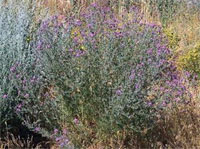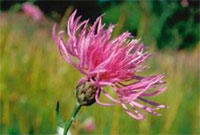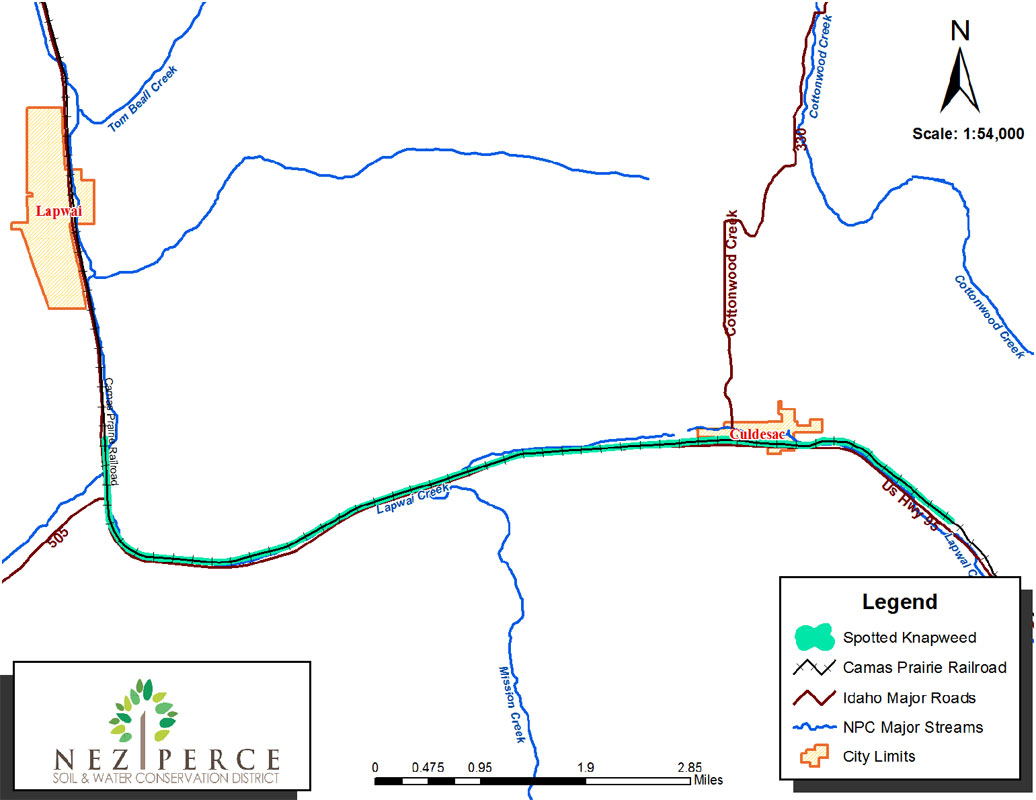Spotted knapweed (Cenaurea stoebe) is an herbaceous biennial plant of the United States. It is a native of Eurasia and was first detected in late 1800s. For more information on this invasive species go to the National Invasive Species Information Center. Information for spotted knapweed was adapted from the Colorado Weed Management Association’s web site.

Figure 1. Spotted knapweed plant. Photograph: Mark Schwarzlander, Univeristy of Idaho, Bugwood.org

Figure 2. Spotted knapweed flower. Photograph: John M. Randall, The Nature Conservancy
Nez Perce County Distribution:
Spotted knapweed is adapted to well-drained, light to coarse-textured soils that received summer rainfall (FEIS 1998, Rutledge and McLendon, 1998). Nez Perce County distribution is along the railroad between the town of Sweetwater and Culdesac and along road banks.
Figure 3. Spotted knapweed distribution in Nez Perce County. blue shaded areas show distribution areas.

Impacts:
- Reduces or displaces plant species
- Spotted knapweed produces allelopathic chemicals that inhibit the growth of other plants (Rutledge and McLendon, 1998)
- Sap of spotted knapweed can cause skin irritation in some people
Biology:
- Spotted knapweed germinates in spring or fall (Beck 1997). Spotted knapweed seedlings develop into and remain as rosettes for at least one growing season while root growth occurs (FEIS 1998). It usually bolts for the first time in May of its second growing season and flowers August through September (Rutledge and McLendon, 1998). Individual flowers bloom for 2-6 days (FEIS 1998). Plants are self fertile and are also cross-pollinated by insects.
- Reproduces entirely by seed and is a prolific seed producer.
- Plants may produce up to 140,000 seeds/m² (Rutledge and McLendon, 1998). Most seeds are shed immediately after reaching maturity.
- Spotted knapweed seeds exhibit three germination behaviors: dormant light-sensitive, dormant light insensitive, and non-dormant (FEIS 1998). Dormant seeds form a seed bank and may remain viable in the soil for over 8 years (Rutledge and McLendon, 1998).
- Knapweed seeds are often spread in hay and on vehicle undercarriages.
CONTROL
Controls include herbicides and bio-control agents. Herbicide applications are very expensive and often difficult to apply in steep terrain. Biocontrol agents are a low-cost long-term alternative.
References:
- FEIS - Fire Effects Information System [Online] (1996, September). Prescribed Fire and Fire Effects Research Work Unit, Rocky Mountain Research Station (producer), US Forest Service. Available: www.fs.fed.us/database/feis/ [1998,March 12]
- Beck, G.K. 1997. Natural resource series, diffuse and spotted knapweed. Colorado State University Cooperative Extension no. 3.110. Internet 05/05/98. Available: http://ozma.jeffeson.co.us/dpt/opennspac/weed/dfknapweed.htm
- Davis, E.S. 1990. Spotted knapweed (Centaurea maculosa) seed longevity, chemical control and seed morphology. M.S. Thesis, Montana State University, Bozeman, MT.
- Fletcher, R.A. and A.J. Renney. 1963. A growth inhibitor found in Centaurea spp. Canadian Journal Of Plant Science 43:475-481.
- Lacey, J.R., C.B. Marlow and J.R. Lane. 1989. Influence of spotted knapweed (Centaurea maculosa) on surface water runoff and sediment yield. Weed Technology 3:627-631.
- Lacey, C.A., J.R. Lacey, P.K. Fay, J.M. Stry and D.L. Zamora. 1995. Controlling spotted knapweed in Montana rangeland. Circular 311. Montana State University Cooperative Extension, Bozeman, MT.
- Olson, B.E., R.T. Wallender, and J.R. Lacey. 1997. Effects of sheep grazing on a spotted knapweed infested Idaho fescue community. Journal of Range Management 50:386-390.
- Mauer, T., M.J. Russo, and M. Evans. 1998. Element Stewardship Abstract for Centaurea maculosa. The Nature Conservancy. Internet 07/28/98. Available: http://tncweeds.ucdavis.edu/esadocs/documnts/centmac.html
- Rutledge, Chris R. and Dr. Terry McLendon. No Year. An Assessment of Exotic Plant Species of Rocky Mountain National Park. Department of Rangeland Ecosystem Science, Colorado State University. 97pp. Northern Prairie Wildlife Research Center Home Page.
- http://www.npwrc.usgs.gov/resource/othrdata/explant.htm (Version 15DEC98).
- Sheley, R.L., and J.S. Jacobs. 1997. "Acceptable" levels of spotted knapweed (Centaurea maculosa) control. Weed Technology 11:363-368.
- Stubbendieck, J., G.Y. Friisoe and M.R. Bolick. 1995. Spotted knapweed. Weeds of Nebraska and the Great Plains. Nebraska Department of Agriculture, Bureau of Plant Industry, Lincoln, Nebraska. pg. 103.
- Watson, A.K., and A.J. Renney. 1974. The biology of Canadian weeds Centaurea diffusa and C. maculosa. Canadian Journal of Plant Science 54:687-701.
- Whitson, T.D.(ed.), L.C. Burrill, S.A. Dewey, D.W. Cudney, B.E. Nelson, R.D. Lee, R. Parker. 1996. Spotted knapweed. Weeds of the West. Western Society of Weed Science, in cooperation with the Western United States Land Grant Universities Cooperative Extension Services, Newark CA. pg. 88.